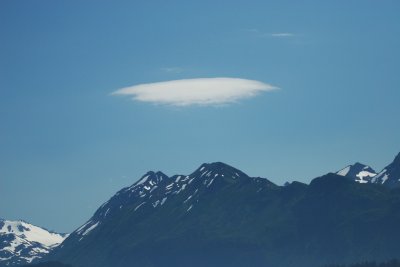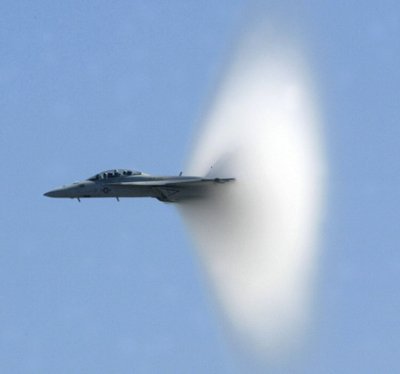Lenticular cloud over mountain peak, Homer, Alaska
Lenticular cloud surrounding F-18 fighter jet
This summer I spent an afternoon sitting on the beach in Homer, Alaska, looking across at the mountains and glaciers of the Kenai Peninsula. It was one of those days when you think you have died and gone to heaven — nice temperature, clear skies, and a procession of boats entering and leaving the harbor, each with a story I make up for them as they sail past.
Then, as afternoon wore on and the wind picked up, I saw the most perfect lenticular (meaning like a lens) cloud I have ever seen. I had remembered to carry my camera and got a photograph (on this page). And recently I encountered a photograph of a fighter jet completely surrounded by a cloud created in the same way, so, thinking about this topic, I decided to write an explanation.
The man on the street probably thinks atmospheric physics is child's play compared, for example, to particle physics or cosmology. But in many ways the latter topics are simpler and more predictable than the atmosphere's behavior. Compare the problem of predicting the path of a planet around the sun, versus the problem of predicting the path of a hurricane across the Atlantic. One can compute the planet's future to a fare-thee-well, but as to the hurricane, an accurate 12-hour prediction is regarded as state of the art.
I'm not going to try to explain all the reasons why the atmosphere is so complex and unpredictable, instead I'll address the more manageable issue of water vapor. Water vapor is a state of water, along with liquid and solid, three states shared by many other elements and compounds. Air can contain quite a lot of water in the form of water vapor.
As it turns out, the amount of water vapor that air can contain depends critically on the air's pressure and temperature. As the air's temperature or pressure drops, so does its capacity to hold water vapor. If the air happens to contain a lot of water vapor (high humidity) and either the temperature or pressure should drop, the water vapor may become liquid water droplets.
Most of us are familiar with the idea that rainy weather is preceded by a drop in atmopsheric pressure and/or temperature. All this means is the change in conditions, the decrease in pressure and temperature, forces the atmosphere's water vapor to become liquid water. But there are some special, even exotic, short-term conditions that can produce a miniature weather system. One example is a lenticular cloud.
Please look at the photograph and think about the conditions over the mountaintop. A region-wide wind is blowing horizontally, uneventfully, across the land. When the air approaches the mountain, it is pushed upward, which causes its pressure to drop (because the atmosphere's pressure drops at higher altitudes). If the air contains a lot of water vapor, the pressure may drop sufficiently that some of the water vapor must become liquid water.
Then the air mass descends on the far side of the mountain, and the process reverses — the liquid water once again becomes water vapor. This can all happen in a matter of minutes, or even seconds in some special cases.
The picture of the fighter jet is such a special case. What is not visible in the picture are the pressures around the fuselage of the jet. Toward the front of the jet, the pressures are higher than normal, because the jet is pushing against the air in front of it, creating a shock wave as it approaches the speed of sound. Toward the rear of the jet, the pressure is lower than normal, because the jet has created a shock wave, and there is typically a near-vacuum behind a passing shock wave. This region of reduced pressure is where the cloud forms, for the same reason that a mountaintop may have a lenticular cloud. Just as with the lenticular cloud seen over a mountain, the jet's accompanying cloud appears and disappears in a very short time in step with the pressure changes.
Warm, high-pressure air tends to have a lot of water vapor, but this is not required. Conisider desert air — there isn't much water in the environment, so there isn't much in the air either. And air at or below freezing has no water vapor at all, which is why a technique known as freeze-drying works.


 Share This Page
Share This Page

 Share This Page
Share This Page




 Share This Page
Share This Page